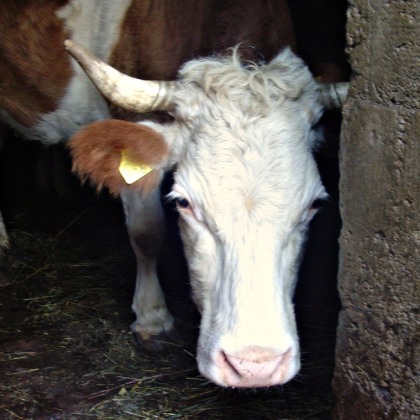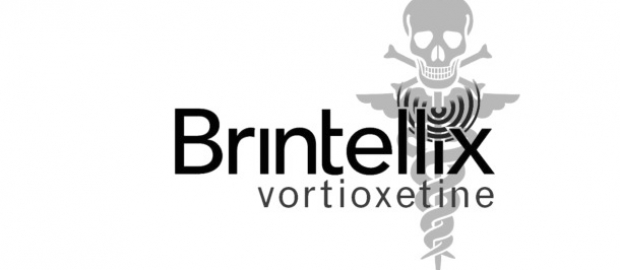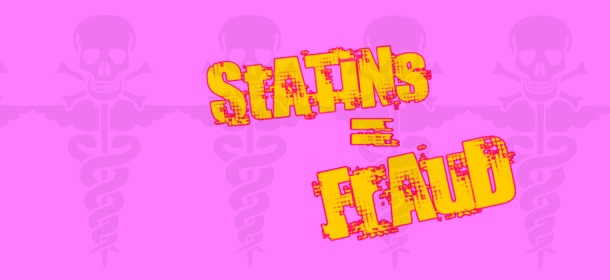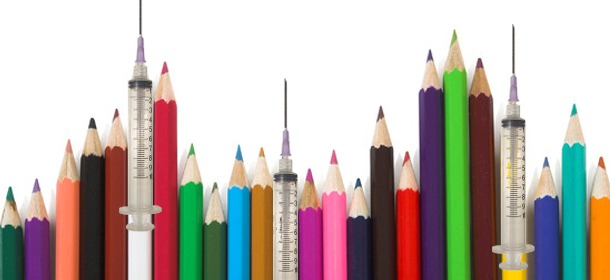Diseases/Conditions
MRSA Found in Conventional Milk Shows Why Raw Milk Is Safer
Pasteurization is nothing more than a showy bandage covering a festering wound created by Agribusiness. But the truth can be seen in news that MRSA is found in vats of milk, but don’t worry, it’s gonna be pasteurized. Raw milk doesn’t produce MRSA.

Short-horned Cow, by CameliaTWU
by Heidi Stevenson
Currently, raw milk is legal in England. It’s the cleanest and healthiest milk you can buy. MRSA-infested milk from standard cruel tightly-packed operations—milk that must be pasteurized to be rendered anything close to safe—has been found in bulk milk.
If you drink milk from almost any source other than directly from a caring farmer who provides raw, unpasteurized milk, then you should worry. The plan is not to dump this contaminated milk. No, the plan is to pasteurize it and declare it “safe”.
Of course, pasteurization does nothing to remove the products of the disease, such as toxins produced by the bacteria or pus that the cows produce in an attempt to heal themselves. So, any time you purchase standard commercial milk, you should assume that you’re getting something beyond the milk itself—but don’t expect to find it on the label.
The pressure is on conventional milk producers to get every last ounce they can from their poor miserable cows. They milk them when they’re sick. They milk them when they have mastitis. They dose them with strong antibiotics, and when they still get sick, they give them ever more—and they keep milking them through it all. Surely it’s obvious that healthy milk cannot possibly come from such a source.
On the other hand, raw milk is delivered by healthy cows. On the rare occasions when a raw milk producer becomes sick or gets mastitis, that cow is temporarily retired from producing milk for sale. She may be given antibiotics to help her heal, though some farmers treat with homeopathy, but she is not returned to milking until she’s again healthy and needs no further treatment.
Conventional cows are usually raised in concentrated feed lots and forced to eat unnatural foods, like grains and even ground-up animal parts. Healthy cows that live a more natural life in fields and eat a natural diet of grass produce raw milk.
Conventional cows deliver considerably more with their milk. They deliver antibiotics and any other drugs they’ve been given. Since they’re often sick, they deliver pathogens and their toxins, and pus. You can be fairly sure that you’ll get at least some of these items any time you buy conventional milk because the milk is collected in mass storage vats, so you’re getting the milk from many cows of many feed lots.
Healthy raw milk cows deliver nothing but healthy milk. Since it’s purchased directly from the farmer, you know precisely what farm your milk came from.
Nutritional Differences in Raw and Pasteurized Milk
Pasteurization changes milk. It is much more able to grow bacterial pathogens. Raw milk inhibits bacterial growth.
Scurvy is much more common in children who drink pasteurized milk. Granted, that’s not a major issue today, but it is indicative of the destruction of vitamin C by pasteurization.
Teeth are less likely to decay on raw milk than on pasteurized.
Pasteurization causes calcium to be more tightly bound to milk. As a result, pasteurized milk is a poor source of calcium, but raw milk is an excellent source.
Pasteurization destroys as much as 80% of vitamins A & E. It can destroy anywhere from 38-80% of B vitamins and 25-50%, often more, of vitamin C. Raw milk, obviously, provides the full complement of these nutrients.
Vitamin B is produced by lactic acid bacteria, which are killed by pasteurization. Probacteria keep raw milk from putrefaction, that is, decaying or rotting. It turns sour and is still nutritious and usable as yogurt, cheese, and other cultured forms of milk. On the other hand, by killing off the beneficial bacteria, pasteurization causes an increase in the growth of harmful, disease-producing bacteria. Therefore, pasteurized milk is far more likely to contain disease-producing organisms than raw milk.
Protein is destroyed by pasteurization. Many minerals are lost by volatilization (evaporation).
Pasteurization is heating. Heating milk destroys enzymes. Enzymes are required to release nutrients in the foods we eat. Phosphatase is an enzyme destroyed by pasteurization. It’s necessary for the release of calcium. Therefore, though the industry and governments tout the high calcium level in milk, it’s largely inaccessible once it’s been pasteurized. Of course, raw milk is still an excellent source of calcium.
Benefits of Pasteurization
Clearly, human health doesn’t benefit from pasteurization. There is, though, one beneficiary: Agribusiness. Farmers of milk bound for pasteurization have little motivation to keep their facilities clean, so most don’t. The cows live in degrading and degraded environments. Their lives are shortened dramatically.
Their suffering and the destroyed health benefits of milk are the price paid for profits to a smaller and smaller number of people, those who are at the helm of Agribusiness.
That’s all. They’re the only beneficiaries of pasteurized milk. The animals lose. The land and environment lose. And the people lose.
Promotion of Pasteurized Milk
So why is it becoming all but impossible to obtain raw milk? Agribusiness is all about money, and uses it to suppress and delegitimize anything but what they produce. Therefore, they’ve virtually taken over governmental agencies that are supposed to be protecting us. So, instead of protecting us and the environment against the depradations of Agribusiness, they protect Agribusiness from genuine choice of the people.
People not only still want raw milk, more and more are making the decision to buy it. Propaganda campaigns haven’t been enough to completely squelch it. Now, governmental agencies, at the behest of their corporate masters, are making the final moves to completely ban it, to make sales and purchase of raw milk illegal.
In the US, the FDA has done full SWAT operations against raw milk producers and stores that sell it. In the UK, the FSA is now moving to ban it completely. In their Microbiological Safety of Raw Drinking Milk, they state that pasteurization of all milk should be a “critical control measure and is the most effective means of protecting public health”. In recognition of the fact that many people do drink raw milk, they suggest that “a clear, consistent and appropriate regulatory framework to control the public health risk, particularly in the light of developments in the marketing of these products”.
In other words, they want to place more and more restrictions on raw milk to make it harder to produce and purchase. They hope to do this in the face of the admission that “the available data indicates that there have been no reported outbreaks of illness associated with raw drinking milk or cream in England and Wales since 2002.” They discuss historical situations in which people did die from drinking raw milk, mostly from tuberculosis. What they don’t note, though, is that these deaths occurred during the earliest stages of modern milk production, with its concentrated feed lots and mistreatment of animals.
The FSA makes clear that the EU allows restricting raw milk. They take a strong stand against children, pregnant women, and the elderly drinking it. And if they aren’t stopped, they will effectively ban it.
The Raw Truth
What should be abundantly clear is that raw milk is far healthier than pasteurized. The bulk of milk’s health-producing factors are destroyed when it’s pasteurized. Safety is provided by raising healthy cows in life-affirming environments. It doesn’t come from filthy crowded environments and sick animals. It isn’t provided by the destruction of health-producing elements, and it doesn’t come from treating food of any sort as nothing but a commodity that exists for only one purpose, profits.
The truth is that reducing the nature of food to the most efficient and profit-producing materials possible is counterproductive. Health doesn’t come from sick animals and pasteurization is nothing more than a showy bandage covering a festering wound.
As Dr. William Campbell titled his book, The Milk of Human Kindness is Not Pasteurized.
Sources:
- MRSA found in our milk: Superbug strain can cause serious infections in humans and is resistant to antibiotics
- New MRSA superbug strain found in UK milk supply
- Abstracts on the Effect of Pasteurization on the Nutritional Value of Milk
- Food Standards Agency, Microbiological Safety of Raw Drinking Milk
- Milk Pasteurization
- The Safety of Raw Milk
- Microbiological Safety of Raw Drinking Milk
Tagged agribusiness, anti raw milk propaganda, conventional milk putrefaction, conventional milk unhealthy, fsa raw milk, mrsa milk, mrsa pasteurized milk, no mrsa in raw milk, pasteurization agribusiness, pasteurized milk lack of safety, pasteurized milk unsafe, raw milk health, raw milk healthy, raw milk safety














Pingback: MRSA Found in Conventional Milk Shows Why Raw Milk Is Safer | Knowledge Wealth Centre
Pingback: MRSA: Glücksspiel mit der öffentlichen Gesundheit? | Schwein gehabt?